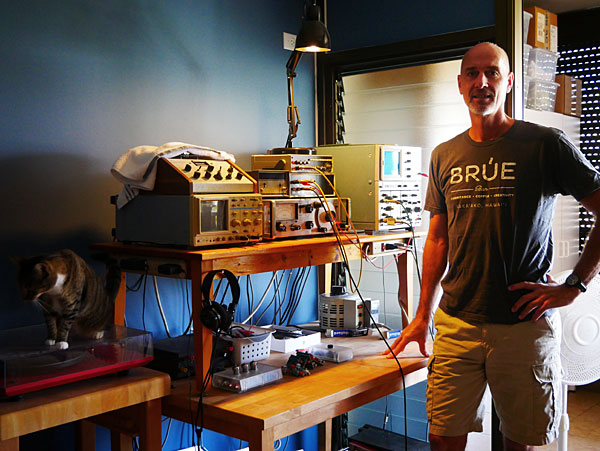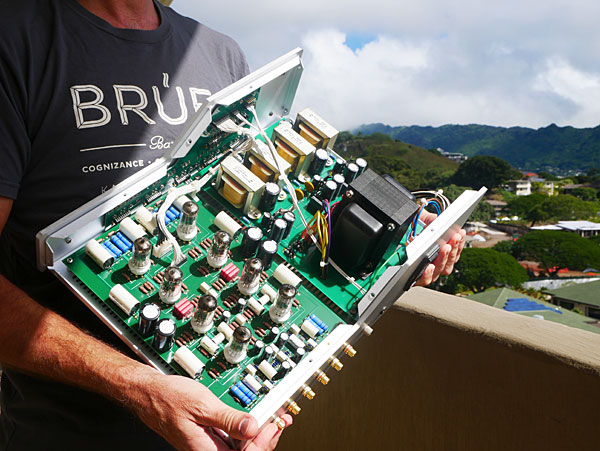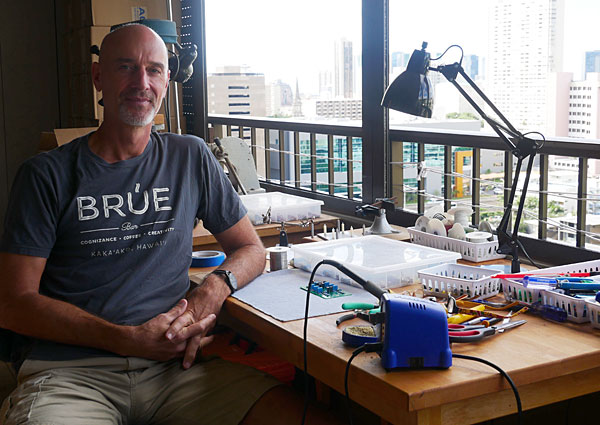| Columns Retired Columns & Blogs |
Straight shooter. No BS. I like it.

Additionally, his Trumpet Reference—MM/MC vacuum-tube phono preamplifier, has been a Stereophile Class A Recommended Component for a few years now.
During a trip back home to O'ahu for the holidays, I reached out to Jim and was kindly invited to visit his home, which doubly functions as his live-in audio workshop. I started off by asking him to share more about his background in life, audio, and electronics.
Jim Hagerman: I grew up in Minnesota and went to college there. There weren't any jobs at the time so I went east to Boston. A friend of mine had gone over there and said I should check it out. For a couple years I did that, didn't think I'd ever leave. I grew up in the Midwest and had no desire to go crazy traveling. I spent eight years in Boston, and that's where I met my ex-wife. We went to San Diego after that.
It was good for me career-wise. I worked at Digital Equipment, so I worked on all kinds of different types of equipment for a long time. In SD, I was at Hughes Aircraft and Nokia; worked on mobiles phones, TVs. At Hughes, we invented what they call the "D-ILA", now owned by JVC. They're large-screen TV projectors. (The technology was actually invented by Hughes about 30 years ago.) We were doing the first movie-theater-sized electronic projection, at least in color. There was also General Electric, Eidophor, and some others that were doing things.
That was fun. Analog electronics. For me, it helps in the audio world, especially doing radio frequency stuff. When you're up in the megahertz and gigahertz, it's a different world. Very analog. Everything—position, trace length, RF, digital, it's all very critical. That's what I bring to the audio world that I think a lot of other people don't have.

Jana Dagdagan: Were you always an audiophile?
JH: Well, I've got the same story as everyone else who got in this business. You're 16, you go into an audio store, and you're just blown away by something. For me, it was Klipsch horns, a tube amp, and a Supertramp album: Crime of the Century. We were just stunned. The guy brought us in (knowing he wasn't going to sell us anything), sat us down, turned it way up, and left the room. It was just breathtaking. I ended up buying my first audio equipment from those guys. (This was in Minneapolis.) I got the Advent Model 300, which was kind of a cult receiver at the time, and little Advent speakers.
Since then, I grew up playing trumpet, so I knew how to read music and play. I was in the jazz band and orchestra . . . but I kind of sucked! (Laughs) I wasn't a "musician type" and . . . I'll confess I'm not really an audiophile, like most of our customers.
JD: If you're not an audiophile, then what are you?
JH: I'm a designer. An inventor/designer/creative type. I'm not a musician, and I'm not really an audiophile. I don't collect. I do it mostly as a business. I do it to try and understand what the customer likes and dislikes. But technically I'm not an audiophile myself. My advantage is: I'm a designer—a product designer and circuit designer, so I was able to bring my skills into this arena.
JD: But...you must be an audiophile to some degree to be in this industry, right?
JH: Actually, in the early '90s, I was going to do guitars, guitar amplification. The guy I was working with, Nestorovic—his Dad, Mile, used to work for Mcintosh and then he started his own company. He had a speaker design . . . He mentioned that his father wanted to get out of the business and sell it. I thought about it but decided to go with guitars instead because it was a bigger market. Vacuum tubes were a big business, and everybody who knows how to design with them is either retiring or dead. There's nobody left. It's just a couple of young guys trying to pick up the torch. There were a handful of people doing it way back when.
I thought, "Oh, that's it! I'm going to learn these things." I really got into it. I read everything and studied for years. I figured there was a business in there for me somewhere in the vacuum tube world. I thought it was going to be guitar amps and preamps, maybe pedals. But somehow, I don't know how I got diverted. I decided to do a phonostage, because that's the most difficult thing you can do, right? The high-powered amp is one end, the line stage in the middle is the easiest, and phonostages are probably the hardest. Tiny, tiny signals, you're fighting noise, hum, and everything else . . .
After that, I wrote a paper on RIAA networks for an audio publication in '95. So I thought, "okay I'm going to try high-end audio!" And I did.

JD: Is Hagerman Audio Labs just you?
JH: Yes, it's just me. I build everything from scratch myself. I always thought it would grow into something larger, but for that I'd need a partner. I need the marketing and sales side; my business is completely missing that half.
JD: You used to make DIY kits for your affordable components, right? Are you not doing DIY anymore?
JH: Everything I used to do was a kit. I've taken them all off the site. It started as a good business, but you don't make any money that way, and people kind of look down on it. They think, "Oh, it's a kit, there are compromises, it's not as good as it could be, you have to sacrifice things to make it a kit, it's not a quality product." No. These are some really good things. Here I'm giving you world-class technology and sound.
So yeah, I quit doing kits. A lot of people were just cheap and wanted to save 50 bucks. There were all these people with no skills building kits. I'd be getting calls/emails all the time. People would send me broken machines to fix and send back. I spent way more time on the kits than anything else. It wasn't actually profitable, so I slowly killed them all off. I'm trying to get rid of that "oh, it must be low quality because it's a kit" stigma.
It was a good way to get into the business from the bottom up. You could offer a board for 30 bucks and people would love it. You'd kind of build a little bit of a cult following. I don't visit the bulletin boards or forums anymore, but people used to pass the word on and say, "I built this thing and it works great!" So it did help build the business, but at this point it's just not worth the trouble for me.
JD: What are your thoughts on digital?
JH: I gave up digital in 2008. I refuse to touch that stuff any more. The digital world pissed me off so much with the DRM. I had a really good DAC that would do Red Book CDs but then it got crazy with all these different formats and data rates. A universal product is really compromised because you've got too much going on in one box.
JD: Any opinions on MQA? It doesn't make you want to revisit digital?
JH: No opinion other than it looks like a really clever technology. I don't know how it sounds but it's a clever way to combine everything and be compatible. I've heard some horrible stories about MQA and licensing. They're brutal with their licensing for manufacturers who want to use it and employ it. They sting you. For the small guy like me, I don't think I could afford to get into that business.
So nope! Not going back. I've been an analog guy all my life. Digital seemed like the right thing to do so I brought a very analog approach to when I designed that [the DAC], but I don't want to get into that world anymore. I'd rather just buy vinyl.

JD: What's in your listening system?
JH: Mostly my own equipment. Right now I'm using a heavily modified Rega turntable with a VTA adjuster and a new counterweight on the tonearm. Other than that all the electronics are my own. Whatever I happen to have on hand, I'll use for a phono stage. The step-ups are from Bob's Devices. Bob Sattin makes a killer product—the best thing for the dollar. And it's [my system's] just headphones right now, I don't have room for speakers.
JD: What are you listening to right now?
JH: Dave Brubeck's Time Out, Michael Hedges' Aerial Boundaries, Patricia Barbara (Nightclub has a couple of tracks on it that are just fantastic for listening deep, deep down into the noise floor, where you're listening to decays. I spend a lot of time listening to the quiet passages, because you need a really good signal to noise ratio, because you've got all this hiss that's playing at the same time. The music level can go well below the level of hiss. And that doesn't happen with digital; the decay just ends and is gone.)
JD: What do you love/not love about this industry?
JH: What I don't love: The hype marketing. Like "put this crystal in the other room", "put a chocolate chip on top of your tonearm and everything will sound better but it's a $300 chocolate chip". It's a lot of bullshit and they don't back it up with anything but complete gobbledygook. There's no science or physics behind it. There're a lot of people with integrity and then there're the snake oil guys who're just trying to get rich.
I don't like the snake oil. I'm the only guy publishing schematics online. Like, here's what you're buying, this is the real stuff. And . . . there is a downside. I do get copied. There's this guy in Hong Kong doing an exact copy of my Bugle, shipping it for half the cost.
What I love: the people. I totally love the shows, hanging out; it's a great group of people who love what they do. I wish I was more participatory and could go to more shows, but it's expensive. Especially with living out here.
JD: Is there anything you wish audiophiles would understand better about designing?
JH: The key is topology. It's not just the parts you use. That's where I come in—I can invent new topologies and improvements. A lot of guys take an existing design and try to improve on it by using better and better parts. But you could take your basic phono stage and you could throw a million dollars of parts at it, and it'd only go so far. You can throw all the money in the world at it, but a better topology with cheap parts would completely toast it.
JD: Who do you respect, in terms of design?
JH: 1) Alan Blumlein: one of the greatest inventors of all time. He invented stereo—but that's not his good stuff; the good stuff is the differential pair, the resonant sweep circuit for horizontal on television (the most brilliant circuit ever!) 2) Tesla, 3) Thomas Edison. And two of the modern day: Jim Williams and Bob Pease. Super gifted electrical engineers who could think outside the box.

Straight shooter. No BS. I like it.

Don't people contact each other anymore?

Shoots from the hip and is honest with his opinions. Great interview.

"What I don't love: The hype marketing. Like "put this crystal in the other room", "put a chocolate chip on top of your tonearm and everything will sound better but it's a $300 chocolate chip". It's a lot of bullshit and they don't back it up with anything but complete gobbledygook. There's no science or physics behind it. There're a lot of people with integrity and then there're the snake oil guys who're just trying to get rich."
We all know the companies of which he speaks. Synergistic Somethingorother, Nordon't,ect...Well said Jim!

This review with JIM and the one with Ken Ishiwata are the best reviews in the past 10 years Thanks Stereophile

What refreshing comments from JH! Said everything that I have thought about audio and it's marketing hype along with all the snake oil that abounds.
Audio needs more people to speak openly and honestly like this instead of hyping the next buzzword they are trying sell.

Sure is refreshing. But so is that there remains those interested in some plain (honest) talk.
This is something I'll explore (in all its facets) in an upcoming publication.
It's time, for some straight-talking (money-saving?) sensibility.
peter jasz

What piece of (tube) gear is Jana Dagdagan holding ?
For goodness sake, is it that difficult to describe the photo ?
In any case, it looks like a wonderful (phono stage/amp?) piece !
pj